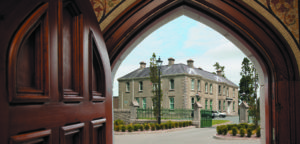LAUNCH OF
STEPS ON MY PILGRIM JOURNEY
MEMORIES AND REFLECTIONS BY CARDINAL CAHAL B. DALY
BANK OF IRELAND ARTS CENTRE, DUBLIN
TUESDAY, 1 SEPTEMBER, 1998, 12.30PM
ADDRESS BY MOST REV. SEÁN BRADY, DCL
ARCHBISHOP OF ARMAGH
I warmly congratulate Cardinal Daly on completing the writing of this fine work which he has chosen to entitle Steps on my Pilgrim Journey. I congratulate Veritas on its elegant publication. Cardinal Daly is emphatic that this is not an autobiography but rather “an assortment of somewhat random memories”. It is indeed that but much more. It is the fruit of the Cardinal’s extraordinary memory of so many of the outstanding events in the life of the Catholic Church in Ireland and in the world during the greater part of this century. It also contains very perceptive profiles of many of the leaders of the Church over the same period.
There is a Persian proverb which says that the best memory is that which forgets nothing but injuries, a memory which writes kindness in marble and injuries in the dust. Cardinal Daly has written the kindness with remarkable clarity of recall. He has written movingly of the kindness of all those who have helped him on the steps of his pilgrim journey. That journey began in his beloved Loughguile – a place that he says always has been and always will be “home”. The journey took him next to St Malachy’s College, Belfast and Queen’s University. Next stop was St Patrick’s College, Maynooth. From there he returned to teach briefly in St Malachy’s College, before his appointment to the Department of Scholastic Philosophy, Queen’s University, Belfast.
It was said of Pope John XXIII that he was always at God’s disposal – not for a life of contemplation although he had the qualities this life demands – but for a life of priestly service to souls and in circumstances which were radically changed eight times during his life. I think that the same could be said of Cardinal Daly. Despite the demands of his busy pastoral life, he has managed to find time for much contemplation and reflection. The fruits of that contemplation are to be found in this volume which make it much more than a mere chronicle of the recollections of a long and fruitful life.
Steps on my Pilgrim Journey reveal much to those who wish to know its author better. Firstly there is the influence of his parents and of his family, and of his teachers in passing on to him their strong faith in God and their dedication to living out that faith in their daily lives.
Then there is the memory of all those priests and professors whom providence had placed on his path and who had a profound influence on his training and formation – the Dr Hendleys, the Professor Henrys. Cardinal Daly writes their kindness in finest Carrara.
I enjoyed reading all of this book and I have learned a lot from it. I particularly enjoyed reading Chapter Seven which deals with the Second Vatican Council. It is certainly the best-informed, most impartial and most enlightened account of the Vatican Council from an Irish perspective which I have read. This is not surprising since it comes from the pen of someone who was already engaged in the Christus Rex Society for almost twenty years – a Society which had played an important role in the renewal of the Church in Ireland in the lead up to the Council by involving laity directly with priests in discussion of pastoral and social issues. Also Cardinal Daly’s experience of reading philosophy and of study in Paris in 1952-55 prepared him well for his attendance at the Council. The great renewal of the Church soon to be brought about by the Vatican Council was already being prepared in France during those years.
All of this ensured that Cardinal Daly was excellently prepared and ideally placed to understand what was taking place at the Council and its profound significance for the life of the Church.
Cardinal Daly was fortunate enough to be able to attend all the sessions of the Vatican Council – first as theological advisor to Bishop William Philbin and later to Cardinal William Conway. He found the experience to be spiritually enriching – an extraordinary event of tremendous benefit. He came away from the Council, he says, feeling the need to acquit himself of a debt of gratitude.
Over the last thirty years he has indeed discharged himself of that debt of gratitude by taking the Council documents as the guide and inspiration of his life as a diocesan bishop. Now once again he discharges that debt by writing this masterly account of his participation in the Vatican Council. He has placed us all deeply in his debt by doing so.
Indeed, I found the account of his thirty years as a bishop a challenging not to say daunting one. He highlights the welcome and the cooperation which he received from the priests, religious and laity in the three dioceses in which he has served, Ardagh & Clonmacnois, Down & Connor and Armagh. I am very happy to say that the same spirit of loyalty and generosity continues to flourish in the diocese of Armagh. The welcome and help which he himself gave to me on my arrival in Armagh were the essence of thoughtfulness and consideration.
Chapter Ten entitled, Thirty Years a Bishop, is essential reading for anyone who wants to understand the history of the Catholic Church in Ireland in the second half of the Twentieth Century. The social imperative of his first years in the priesthood is now joined by the ecumenical imperative, the catechetical imperative, the peace imperative. The list goes on and in doing so it reflects his many cares and concerns over those thirty years. In the Prologue to Steps on my Pilgrim Journey he refers to the possibility of some omissions among the assortment of memories collected therein. The only glaring omission which I can find is an acknowledgment of the immense load of work which the Cardinal carried out for the Irish Conference of Bishops over those thirty years.
I have already said Steps on My Pilgrim Journey is not just the Chronicle of a long and fruitful life. It is also a Spiritual Testament, a Journal of a Soul. In it the author shares with his readers the scriptural passages which have given him courage and strength over the years. He has shared his vision of priesthood and of service to the Church. He reveals again his great confidence that by the power of the Risen Lord the Church is always given the strength to overcome the afflictions and hardships which assail it both from within and without. He quotes a remark of Mgr John Quinlan during the first session of the Council describing Cardinal Montini as “the barometer of the Council”. I think Cardinal Daly could aptly be described as the barometer of the Irish Church.
Probably the most pleasing aspect of this book for me was the determination of the author “not to forget in the darkness what we have seen in the light” of the Church. I have seen this word “defensive” used in describing certain parts of its contents. What else does one do but defend when someone or some institution which we value and love, is being attacked or misrepresented?
Cardinal Daly has dealt with several other aspects of his life and spirituality such as his devotion to Mary, the Mother of God, and to the Saints, especially St Therese of Lisieux. The texts of sermons preached on special occasions, such as arrival in or departure from three dioceses, to priests, religious and lay faithful, provide a precious insight into the struggles and the testing of faith which are always part of the pilgrim way of the Church itself. His soul is certainly to be found in those pages.
The final chapter is entitled, Full of Hope. There the Cardinal identifies some priorities for pastoral planning and action for the immediate future. The emphatic message is that this is not a time for discouragement, pessimism or fear about the future. Rather it is a time for hope and confidence about all that the future may bring.
Cardinal Daly says he feels a great impatience to do so much more for the Lord and for the Church. Certainly writing Steps on my Pilgrim Journey can give renewed conviction and energy to a lot of other pilgrims on their journey. Long may he continue to provide that sort of welcome, inspiration and encouragement. Thank you, Cardinal, for once more placing your genius, time and energy at the service of the Church by sharing with your readers this eloquent testament of faith, hope and love.



You must be logged in to post a comment.